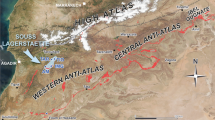Abstract
WITH reference to my preliminary note1 on the results of work by Mr. Pinfold and myself on the Eocene beds of the Punjab Salt Range, we have now determined the fact that, of the six sections of the local Eocene, the lower three (Dhak Pass Beds, Khairabad Limestone and Patala Shales) are all of Upper Ranikot age ; the Patala Shales representing later Ranikot elements than have yet been found elsewhere. The three upper sections (Nammal Shales, Sakesar Limestone. and Bhadrar Beds) are of Lower to Middle Laki age, the unconformity between Ranikot and Laki being rather less on the Salt Range than elsewhere. Our paper on this subject, giving full palseontological details, will appear in due course as the, first part of vol. 24 (N.S.) of the Palaeontologia Indica.
This is a preview of subscription content, access via your institution
Access options
Subscribe to this journal
Receive 51 print issues and online access
$199.00 per year
only $3.90 per issue
Buy this article
- Purchase on Springer Link
- Instant access to full article PDF
Prices may be subject to local taxes which are calculated during checkout
Similar content being viewed by others
References
NATURE, 135, 188 (Feb. 2, 1935).
Author information
Authors and Affiliations
Rights and permissions
About this article
Cite this article
DAVIES, L. Extent of the Ranikot Sea. Nature 139, 414–415 (1937). https://doi.org/10.1038/139414b0
Issue Date:
DOI: https://doi.org/10.1038/139414b0
This article is cited by
-
Stratigraphic evidence for an early collision between northwest India and Asia
Nature (1995)
-
Age of the Saline Series in the Salt Range of the Punjab
Nature (1944)
-
Westward Extension of the Ranikot Sea
Nature (1938)
Comments
By submitting a comment you agree to abide by our Terms and Community Guidelines. If you find something abusive or that does not comply with our terms or guidelines please flag it as inappropriate.



